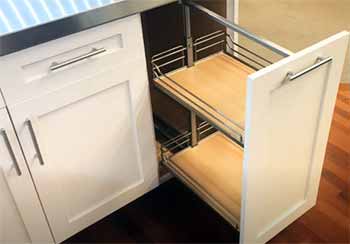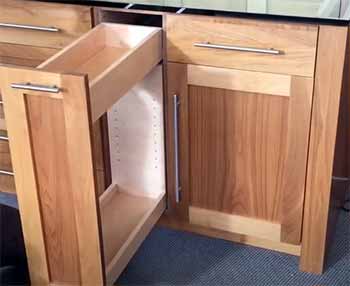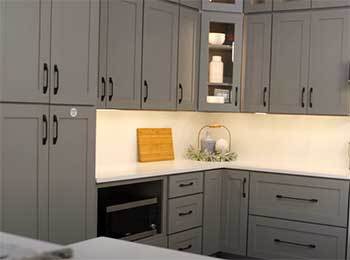If you’re hunting for cabinets that blend quality, customization, and a price that doesn’t make your wallet weep, let me point you straight to Barker Cabinets. I’ve been through the wringer with kitchen remodels, and trust me, these ready-to-assemble (RTA) beauties are worth every penny.
Whether you’re a DIY enthusiast or just someone who wants a stunning kitchen without breaking the bank, Barker’s got your back.
Stick with me as I walk you through my journey with these cabinets, the highs, the lows, and everything in between—you’ll see why I’m sold on them.
My Experience With Barker Cabinets

Picture this: I’m standing in my outdated kitchen, dreaming of a space that’s both functional and gorgeous.
My last place had those generic, cookie-cutter cabinets that screamed “builder-grade blah,” and I was determined to do better this time.
After some late-night Googling and a few too many cups of coffee, I stumbled across Barker Cabinets.
Custom sizing? American-made plywood? Blum hardware? It sounded too good to be true, but I took the plunge and ordered a full kitchen set—22 doors, 9 drawers, and a pantry setup tailored to my weirdly shaped space.
The boxes arrived on my doorstep in Florida, and I’ll admit, I felt a mix of excitement and dread. I’m no stranger to a screwdriver, but assembling an entire kitchen? That’s next-level.
The shipment was hefty, packed tight with ¾-inch plywood pieces, all labeled like a pro organizer’s dream. I cracked open the first box, and the quality hit me right away—solid wood, crisp cuts, and a finish that begged to be touched.
The shaker-style doors I’d chosen (unfinished, since I wanted to paint them myself) were pristine, with pre-drilled hinge spots that made my life easier.
Assembly wasn’t a breeze, but it wasn’t a nightmare either. I’d tackled IKEA furniture before, so I had a baseline. Barker’s instructions could’ve been clearer—more pictures, fewer assumptions about my carpentry skills—but once I got the rhythm, it clicked.
The cabinets screwed together with beefy confirmat screws, no glue or clamps needed, which was a relief since my tool collection is modest. I did borrow a buddy’s impact driver, and wow, that made a difference.
My kitchen started taking shape: a pullout drawer under the sink, a touch-open trash cabinet, and those glorious 26-inch deep base cabinets that swallowed my pots whole.
There were hiccups, though. FedEx roughed up a couple of boxes, and one drawer front arrived with a nick. I emailed Clayton in customer service, expecting a fight, but he was on it—replacements shipped out fast, no hassle.
That kind of support sealed the deal for me. By the end, my kitchen wasn’t just functional; it was mine, down to the custom hood color-matched by Hoodsly to my Barker doors. I’m still grinning every time I walk in there.
Pros of Barker Cabinets
- Unmatched Customization

You know what I love most?
Barker lets you play architect.
Need a cabinet 26 inches deep instead of the standard 24?
Done. Want a 3-drawer setup with a 14-inch bottom drawer for your oversized mixer?
They’ve got you. I designed my kitchen to fit like a glove around my Thermador appliances, and that flexibility is pure gold. No more awkward filler strips or wasted space—every inch works for me.
- Top-Notch Quality
These cabinets aren’t messing around. The ¾-inch plywood feels sturdy enough to survive a hurricane (fingers crossed I never test that). The Blum hinges and Movento slides? Chef’s kiss.
They’re soft-close, full-extension, and rated for serious weight—I’ve got cast-iron skillets in there, and they glide like butter. The shaker doors I painted held up beautifully, no chipping or warping, even with my amateur brush skills.
- Stellar Customer Support
I can’t say enough about Clayton and the Barker team. Every email I sent—whether it was a dumb question about measurements or a panic over a damaged piece—got a quick, helpful reply.
They caught a mistake I’d made in my order (wrong drawer size, oops) before it shipped, saving me a headache. When FedEx botched a delivery, Barker didn’t blink—they sent replacements pronto. That’s the kind of backup you need when you’re elbow-deep in a remodel.
- Cost Savings That Make Sense
Let’s talk money. I got quotes from local cabinet shops that made my eyes water—thousands more than Barker’s price tag. For my full kitchen, including custom sizes and premium finishes, I paid way less than I’d budgeted.
Sure, I had to assemble them myself, but that trade-off meant I could splurge on a killer range instead. You’re getting high-end quality without the high-end markup.
- Easy Assembly (Once You Get the Hang of It)
If you’ve ever wrestled with flat-pack furniture, you’ll manage this. The pieces fit together tight, thanks to precision cuts from their CAD/CAM machines.
No glue, no fuss—just screws and a bit of patience. I’ll admit, the first cabinet took me longer than I’d like to admit, but by the third, I was a pro. Borrow an impact driver, and you’ll thank me later.
Cons of Barker Cabinets
- Assembly Can Be Tricky

Don’t get me wrong—I loved the end result, but putting these together isn’t always a walk in the park.
The instructions assume you’ve got some DIY chops, and if you don’t, you might be scratching your head.
My first attempt had a wonky edge because I tightened the screws in the wrong order.
It’s fixable, but it takes trial and error. If you’re not handy, you might need to rope in a friend or hire someone.
- Shipping Delays and Hiccups
The wait time? Yeah, it’s real. Custom cabinets take 8-12 weeks, and mine leaned toward the longer end. Then there’s the shipping—FedEx didn’t do me any favors, damaging a couple of pieces. Barker fixed it, but it added stress I didn’t need.
And one time, I got an email saying my order shipped, only to find out the label was printed, not picked up. Four days later, it finally moved. Annoying, but not a dealbreaker.
- Design Responsibility Falls on You
Here’s the kicker: Barker doesn’t hold your hand through the design phase. You’re the one measuring, planning, and ordering. I almost botched it by picking a 48-inch wide cabinet that flexed too much—my bad, but a heads-up from them would’ve been nice.
If you’re not detail-oriented, you could end up with a costly mistake. Triple-check your specs, folks.
- Minor Finishing Quirks
Perfectionist alert: sometimes the edges don’t line up just right. I had to loosen and retighten screws to get everything flush, which was a minor pain.
The drawer fronts use two thin screws, and I worried they’d wobble, though they’ve held up so far. And the unfinished wood? You’ll need to sand and finish it yourself if you go that route—extra work, but worth it for the custom look.
Maintenance Tips For Barker Cabinets
- Keep ‘Em Clean and Dry: I learned this the hard way: a splash of spaghetti sauce left too long can stain. Wipe down your cabinets with a damp cloth and mild soap—nothing harsh, please. Those plywood edges soak up water like a sponge if you’re not careful, so dry them off quick. I keep a microfiber towel handy for spills, and it’s kept my finish looking fresh.
- Tighten Up Regularly: Those screws that hold everything together? They can loosen over time, especially with heavy use. I check mine every few months with a screwdriver, giving them a quick twist to keep things snug. The Blum hinges are adjustable too—tweak them if a door starts sagging. It’s a five-minute job that saves you headaches.
- Protect the Finish: If you painted your cabinets like I did, a little TLC goes a long way. I avoid abrasive scrubbers—soft sponges only—and skip the chemical-heavy cleaners. Every year, I slap on a coat of polyurethane over high-traffic spots (like around the sink) to fend off wear. It’s kept my shaker doors chip-free so far.
- Mind the Hardware: The Blum slides and hinges are champs, but they’re not invincible. I give mine a light dab of lubricant (just a drop!) every six months to keep them gliding smooth. And when I’m loading up the drawers, I spread the weight out—those cast-iron pans don’t need to pile up in one spot. Keeps the mechanism happy.
- Watch the Weight: Speaking of weight, don’t overload those shelves. My 26-inch deep cabinets are roomy, but I noticed a slight bow when I stacked too many dishes. Stick to reasonable loads, and you’ll avoid any sagging surprises. I’ve got a system now—plates on one side, bowls on the other—and it’s working like a charm.
Comparison of Barker Cabinet With Other Brands
Let’s pit Barker Cabinets against some heavy hitters in the cabinet world—Lily Ann Cabinets, American Woodmark, and JSI Cabinetry. I’ve been around the block with kitchen upgrades, so I’m breaking this down like a friendly face-off, comparing what I got with Barker to what these other brands bring to the table.
Spoiler: Barker’s got some serious swagger.
- Barker Cabinets Vs. Lily Ann Cabinets

First up, Lily Ann Cabinets.
They’re another RTA player, and I’ll give them props—their designs are sleek, with trendy shaker styles that caught my eye.
Both Barker and Lily Ann use plywood construction, but here’s where I noticed a difference: Barker’s ¾-inch plywood felt heftier, and those Blum hinges?
Pure luxury compared to Lily Ann’s generic soft-close options. Price-wise, Lily Ann’s a tad cheaper for stock sizes, but when I needed custom 26-inch depths for my oversized range, Barker delivered without a hitch—Lily Ann’s customization options were more limited.
Assembly was a wash; both took some elbow grease, but Barker’s screw-only system edged out Lily Ann’s fiddly dowels. For flexibility and premium hardware, Barker’s my pick.
- Barker Cabinets Vs. American Woodmark

Next, American Woodmark. These guys are big-box staples—you’ve probably seen them at Home Depot. They’re pre-assembled, which is a win if you dread a screwdriver like I sometimes do. Quality-wise, though, Barker runs circles around them.
American Woodmark leans on MDF and thinner plywood, and while it’s solid enough, it doesn’t match Barker’s beefy ¾-inch construction or those buttery Blum slides. Cost? American Woodmark can be pricier for comparable sizes, and customization’s a pipe dream—standard sizes only.
I loved Barker’s ability to tailor my kitchen to my Thermador appliances; with American Woodmark, I’d be stuck with awkward gaps. If you want plug-and-play, American Woodmark’s fine, but Barker’s the champ for quality and fit.
- Barker Cabinets Vs. JSI Cabinetry

Finally, JSI Cabinetry—another RTA contender I considered. JSI’s got a rep for affordability, and their cabinets look sharp with clean finishes. Both brands offer plywood builds, but Barker’s precision-cut pieces and CAD/CAM accuracy gave me tighter fits than JSI’s slightly looser joints.
Hardware’s a toss-up—JSI’s soft-close stuff is decent, but Barker’s Blum gear feels next-level, especially with heavy pots in the drawers. Price-wise, JSI undercuts Barker a bit, which tempted me, but their customization options didn’t stretch as far.
My 14-inch deep drawer for the mixer? Barker made it happen; JSI’s catalog left me improvising. Assembly was simpler with Barker too—no glue like JSI sometimes requires. For a custom vibe on a budget, Barker wins.
Frequently Asked Questions (FAQ)
Barker Cabinets are proudly made in the USA, specifically in Tualatin, Oregon. That’s right—American-sourced plywood and hardware, cut and finished right here. It’s a big reason I went with them; I wanted that quality you can feel good about.
Look at the bones: solid wood or thick plywood (¾-inch is a good benchmark) beats particleboard every time. Check the joints—dovetails or sturdy screws mean business. Hardware’s a giveaway too—Blum, Grass, or Salice stuff that’s soft-close and adjustable screams durability. Barker nailed all these for me; that’s how I knew I was onto something good.
It’s a tight race, but Barker’s up there. Conestoga’s a contender with their inset options, and The RTA Store holds its own with polished designs. For my money, Barker’s combo of custom sizing, ¾-inch plywood, and Blum hardware puts it at the top. You won’t find many RTA brands matching that trifecta without jacking up the price.
RTA cabinets, including Barker’s, put the work on you. Assembly can trip you up if you’re not handy, and designing your layout means no room for sloppy measurements. Shipping can be a gamble too—delays or damage happen. For me, the trade-off was worth it, but if you want plug-and-play, RTA might not be your jam.
Wrapping Up
So, why should you buy Barker Cabinets?
Because they’re the real deal—custom, high-quality, and wallet-friendly in a way most brands can’t touch. I’ve lived the transformation, from a dated kitchen to a space I’m proud to show off, and Barker made it happen without draining my savings.
If you’re ready to roll up your sleeves and craft something special, these cabinets are calling your name. Trust me, you won’t regret it.
